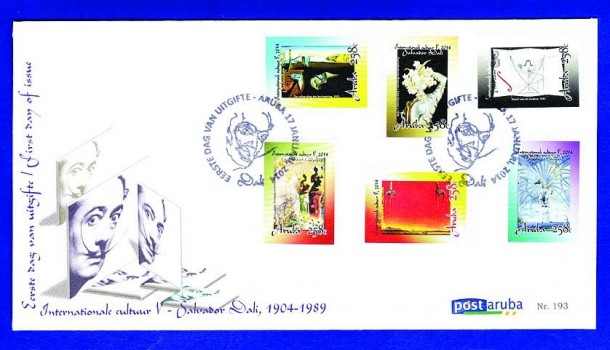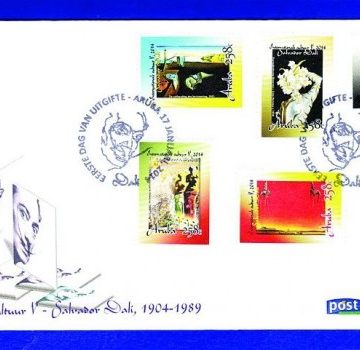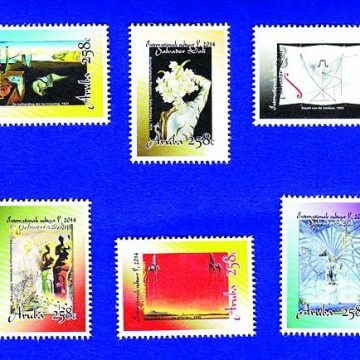Courtesy of: The Morning News
ORANJESTAD — On January 17, 2014 Post Aruba issued its first philatelic issue of 2014: International Culture (Salvador Dalí). This issue consists of 6 stamps and 1 First Day Cover which were adapted by the local artist Michiko Takatsu, using images of the Salvador Dalí paintings. Hereunder there is a short description of the surrealist artist and the 6 stamps.
Salvador Dalí
The Spanish artist Salvador Domingo Felipe Jacinto Dalí i Domènech (May 11, 1904 – January 23, 1989), known as Salvador Dalí, was a groundbreaking icon of the Surrealist movement and one of the greatest artists of the 20th century. His work probed the unconscious world of thoughts, dreams and perception in fanciful and nightmarish images influenced by Freud, Cubism, Futurism and metaphysical art. Extraordinarily imaginative, Dalí also sculpted, and contributed to fashion, photography and theater. Nearly photo- graphic, Dalí’s art has been called the epitome of Surrealism.
Dalí was highly imaginative, and also enjoyed indulging in unusual and grandiose behavior. His eccentric manner and attention-grabbing public actions sometimes drew more attention than his artwork, to the dismay of those who held his work in high esteem, and to the irritation of his critics.
The Persistence of Memory / De volharding der herinnering (1931)
The Persistence of Memory is a 1931-painting by artist Salvador Dalí, and is one of his most recognizable works.
First shown at the Julien Levy Gallery in 1932, the painting has been in the collection of the Museum of Modern Art (MoMA) in New York City since 1934.
The well-known surrealist piece introduced the image of the soft melting pocket watch. It epitomizes Dalí’s theory of “softness” and “hardness”, which was central to his thinking at the time. As Dawn Ades wrote, “The soft watches are an unconscious symbol of the relativity of space and time, a Surrealist meditation on the collapse of our notions of a fixed cosmic order”. This interpretation suggests that Dalí was incorporating an understanding of the world introduced by Albert Einstein’s Special Theory of Relativity. Asked by Ilya Prigogine whether this was in fact the case, Dalí replied that the soft watches were not inspired by the theory of relativity, but by the surrealist perception of a Camembert cheese melting in the sun.
Surrealist Flowers / Surrealistische bloemen (1938)
This striking lithograph is from The Final Editions of the Salvador Dalí collection. This is a breathtaking work of hidden imagery. Posed with the classic lines of Master Dalí’s wife and muse Gala, and in true Dalinian fashion, profiles and faces are buried within the bouquet of flowers creating a surrealistic assemblage of fantastic creatures.
The Swallow’s Tail / Zwaluwstaart (1983)
The Swallow’s Tail — Series on Catastrophes was Salvador Dalí’s last painting. It was completed in May 1983, as the final part of a series based on René Thom’s (a French mathematician) catastrophe theory.
The shape of Dalí’s Swallow’s Tail is taken directly from Thom’s four-dimensional graph of the same title, combined with a second catastrophe graph, the s-curve that Thom dubbed, “the cusp”.
In his 1979 speech, “Gala, Velázquez and the Golden Fleece”, presented upon his 1979 induction into the prestigious Académie des Beaux-Arts of the Institut de France, Dalí described Thom’s theory of catastrophes as ‘the most beautiful aesthetic theory in the world’.
The Hallucinogenic Toreador / De hallucinogene toreador (1968-1970)
The Hallucinogenic Toreador is an oil painting. It is currently being exhibited at the Salvador Dalí Museum in St. Petersburg, Florida. In this piece, Dalí transmits his wife’s dislike for bullfighting. By combining symbolism with optical illusions and estranging yet familiar motifs, he creates his own visual language. His application of the paranoiac-critical method within this painting combines versatile images as an instructive example of his artistic creation.
The entire scene is contained within a bullfighting ring, submerged under a barrage of red and yellow tones, alluding tentatively to the colors of the Spanish flag. In the upper left section we observe a representational portrait of his wife, Gala, to whom he dedicated this piece. Her serious, rigid expression could be interpreted as a pictorial representation of her deep seated dislike for bullfighting. In the bottom left section there is a pattern of multicolored circles.
This rectangular-shaped burst of colors immediately grasps the viewer’s attention and steers it down towards the visibly emerging shape of a dying bull’s head (probably Islero), dripping blood and saliva from its mouth.
The Elephants /De olifanten (1948)
The elephant is a recurring theme in the works of Dalí, first appearing in his 1944 work Dream Caused by the Flight of a Bee Around a Pomegranate a Second Before Awakening, and also in “The Temptation of Saint Anthony” and “Swans Reflecting Elephants. “The Elephants” differs from the other paintings in that the animals are the primary focus of the work, with a barren graduated background and lack of other content, where most of Dalí’s paintings contain much detail and points of interest. The stork-legged elephant is one of the best-known icons of Dalí’s work and adorn the walls of the Dalí Museum in Spain.
There are various cultural depictions of elephants, where they are often viewed as symbols of strength, dominance and power due to their bulk and weight. Dalí contrasts these typical associations by giving the elephants long, spindly, almost arachnid-like legs, once described as “multi jointed, almost invisible legs of desire”. Dalí enhances the appearance of strength and weight by depicting the elephants carrying massive obelisks on their backs, however, on close inspection it can be seen that these weights are floating. The obelisks on the backs of the elephants are believed to be inspired by Gian Lorenzo Bernini’s sculpture base in Rome of an elephant carrying an ancient obelisk, which was mentioned in several communications of the artist, and thus can be considered a reliable claim.
Santiago El Grande / St. Jacob van Compostela (1957)
“Santiago El Grande” is Spanish for St. James the Great, and here Dalí pays spectacular tribute to the Apostle St. James, the patron saint of Spain. He’s shown astride a monumental rearing steed that rises victorious from the sea, dappled in scallop shells, as his – and the entire painting’s – upward motion signifies Christ’s, and ultimately man’s, ascension toward Heaven. The crucified Christ figure is one of the most glorious ever captured on canvas, complete with radiant bands of eternal light emanating from his perfect form – here replacing the sword, often seen in statues of the same heroic theme.
Among other marvelous details in this iconic religious masterwork is yet another portrait of Gala, seen in the lower right corner. And in the hind quarters of the stunningly lifelike horse, we see an atomic cloud burst, reflecting Dalí’s interest in then-new discoveries in nuclear physics and his deepening belief that science and Christianity had more in common than had previously been thought. At the center of the atomic cloud mass is a sweetly painted jasmine flower – a symbol of purity and harmony, and a favorite of Dalí, which he’d sometimes place behind his ears or upon the tips of his legendary mustache!
Anyone who wishes to have this issue can obtain it at the Post Aruba offices in Oranjestad, Palm Beach Plaza Mall, San Nicolas, Santa Cruz, and Harbour Area as of January 17, 2014, until January 16, 2015.
International orders can be placed via the e-mail: ipa747 @yahoo.com






